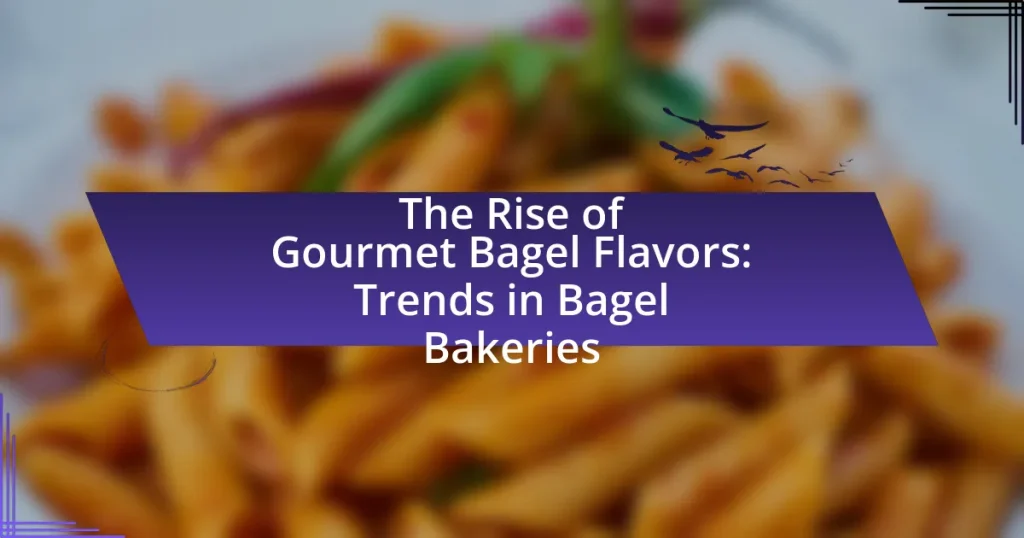The bagel, a ring-shaped bread product, originated in Poland during the 16th century and became a staple in Jewish communities, particularly in Eastern Europe. Its introduction to the United States by Jewish immigrants in the late 19th century marked the beginning of its evolution into a popular breakfast item, further industrialized by the advent of bagel-making machines in the 20th century. The article explores the bagel’s historical significance, cultural influences, and its transformation from a local specialty to a national favorite, highlighting various types, modern innovations, and emerging trends in bagel consumption and culinary applications. Additionally, it discusses best practices for enhancing the bagel experience, including storage and pairing options.

What is the history of the bagel?
The bagel originated in Poland in the 16th century, where it was created as a bread product shaped like a ring. Historical records indicate that the first known mention of the bagel was in 1610, when it was given as a gift to mothers after childbirth. The bagel gained popularity among Jewish communities in Eastern Europe, particularly in Poland, where it became a staple food. By the late 19th century, Jewish immigrants brought the bagel to the United States, particularly to New York City, where it evolved into a popular breakfast item. The introduction of the bagel-making machine in the 20th century further industrialized its production, leading to widespread availability and variations in flavors and toppings.
How did the bagel originate?
The bagel originated in Poland during the 16th or 17th century, primarily as a bread product for Jewish communities. Historical records indicate that the bagel was created as a ring-shaped bread, possibly inspired by the circular shape of a stirrup, which was a nod to the horse culture of the time. The first documented mention of the bagel appears in a 1610 decree from the city of Kraków, which granted bagels as a gift to women who gave birth. This historical context supports the bagel’s significance in Jewish culture and its evolution into a popular food item.
What cultural influences shaped the bagel’s early development?
The bagel’s early development was significantly shaped by Jewish cultural traditions, particularly those of Eastern European Jewish communities. These communities introduced the bagel to the United States in the late 19th century, where it became a staple food. The bagel’s unique shape and boiling process are believed to have originated from the traditional bread-making techniques in Poland, where it was often served during religious celebrations. Historical records indicate that the bagel was mentioned in Jewish texts as early as the 17th century, further solidifying its cultural significance.
What role did immigration play in popularizing the bagel?
Immigration significantly contributed to the popularization of the bagel, particularly through the influx of Eastern European Jewish immigrants to the United States in the late 19th and early 20th centuries. These immigrants brought their culinary traditions, including the bagel, which was originally a staple in Jewish communities in Poland. As they settled in urban areas, especially New York City, they established bakeries that produced bagels, making them accessible to a broader audience. By the 1920s, bagels had transitioned from a niche ethnic food to a mainstream item, largely due to the efforts of these immigrant communities and the subsequent integration of bagels into American breakfast culture.
How has the bagel evolved over time?
The bagel has evolved from a simple boiled bread roll into a versatile culinary item. Initially, bagels were made by hand in Poland during the 16th century, primarily as a staple for breakfast among Jewish communities. Over time, the bagel’s popularity spread to the United States, particularly in New York, where it became a symbol of Jewish culture. In the late 20th century, bagels underwent further transformation with the introduction of various flavors, toppings, and fillings, such as cream cheese, lox, and even gourmet options like avocado or bacon. This evolution reflects broader culinary trends and consumer preferences, making the bagel a canvas for diverse culinary creativity.
What significant changes occurred in bagel production methods?
Significant changes in bagel production methods include the shift from traditional hand-rolling and boiling to automated processes and the introduction of steam ovens. Historically, bagels were made by hand, requiring skilled artisans to shape and boil each bagel individually. However, advancements in technology have led to the use of machinery that can mass-produce bagels, allowing for consistent shapes and sizes. Additionally, the use of steam ovens has improved the baking process, resulting in a chewier texture and enhanced flavor. These changes have enabled bagel production to scale up significantly, meeting the growing demand in various markets while maintaining quality.
How did the bagel transition from a local specialty to a national favorite?
The bagel transitioned from a local specialty to a national favorite primarily through the influence of Jewish immigrants in the early 20th century, who popularized it in urban areas like New York City. As these communities grew, bagels became widely available in bakeries and delis, leading to increased demand. The introduction of bagels into mainstream American culture was further propelled by the rise of bagel shops and chains in the 1980s, such as Einstein Bros. Bagels, which marketed them as a versatile breakfast option. This commercialization, combined with the bagel’s adaptability to various toppings and fillings, solidified its status as a beloved national food.

What are the different types of bagels?
There are several types of bagels, including plain, sesame, poppy seed, everything, onion, garlic, cinnamon raisin, and whole wheat. Each type features distinct toppings or flavors that cater to various preferences. For instance, the everything bagel is topped with a mix of seeds and spices, while the cinnamon raisin bagel incorporates sweet elements, showcasing the versatility of bagels in culinary applications.
What are the traditional varieties of bagels?
Traditional varieties of bagels include plain, sesame, poppy seed, onion, garlic, and everything bagels. These varieties have distinct toppings or flavors that define them, with plain bagels being the most basic form. Sesame and poppy seed bagels feature seeds baked onto the surface, while onion and garlic bagels incorporate these ingredients into the dough or as toppings. The everything bagel combines multiple toppings, typically including sesame, poppy seeds, onion, garlic, and salt. These traditional varieties have roots in Eastern European Jewish cuisine, where bagels originated, and have become widely popular in various culinary contexts.
How do different regions influence bagel flavors and styles?
Different regions significantly influence bagel flavors and styles through variations in ingredients, preparation methods, and cultural preferences. For instance, New York bagels are known for their dense, chewy texture achieved by boiling them in water before baking, while Montreal bagels are smaller, sweeter, and often boiled in honey-sweetened water, resulting in a different flavor profile. Additionally, regional toppings and fillings reflect local tastes; for example, bagels in the Midwest may feature more savory options like cheese and bacon, whereas those in California might incorporate health-conscious ingredients like avocado or smoked salmon. These regional distinctions are rooted in historical immigration patterns and local culinary traditions, showcasing how geography shapes food culture.
What unique toppings and spreads are commonly used with bagels?
Unique toppings and spreads commonly used with bagels include cream cheese, smoked salmon, capers, and various flavored spreads such as chive, garlic, and herb. Cream cheese is the most traditional spread, often paired with smoked salmon, which adds a savory element. Capers provide a briny contrast, enhancing the overall flavor profile. Additionally, flavored cream cheeses, such as those infused with herbs or spices, have gained popularity, reflecting the bagel’s evolution into a versatile culinary canvas.
How do modern bagels differ from traditional ones?
Modern bagels differ from traditional ones primarily in their ingredients, preparation methods, and flavor profiles. Traditional bagels are made from simple ingredients like high-gluten flour, water, yeast, and salt, and are boiled before baking, resulting in a dense and chewy texture. In contrast, modern bagels often incorporate a variety of additional ingredients such as sweeteners, flavorings, and toppings, leading to a wider range of flavors and textures. For example, some modern bagels may include ingredients like malt syrup, honey, or even pumpkin spice, reflecting contemporary culinary trends. Additionally, the rise of artisanal and gourmet bagels has introduced variations that may be baked instead of boiled, altering the traditional chewy characteristic.
What innovations have emerged in bagel recipes and ingredients?
Innovations in bagel recipes and ingredients include the introduction of alternative flours, such as almond and gluten-free options, which cater to dietary restrictions. Additionally, flavor enhancements have emerged, with ingredients like activated charcoal, matcha, and various spices being incorporated into the dough. The use of artisanal techniques, such as cold fermentation and wood-fired baking, has also gained popularity, resulting in unique textures and flavors. These innovations reflect a broader trend in the culinary world towards customization and health-conscious choices, as evidenced by the increasing demand for specialty bagels in gourmet bakeries and cafes.
How has the health trend impacted bagel offerings?
The health trend has significantly influenced bagel offerings by prompting the introduction of healthier ingredients and alternative options. Many bagel manufacturers now produce whole grain, gluten-free, and low-carb varieties to cater to health-conscious consumers. For instance, the rise in demand for high-fiber and protein-rich foods has led to the creation of bagels made with ingredients like quinoa and seeds, which provide enhanced nutritional value. Additionally, the trend has encouraged the reduction of preservatives and artificial additives in bagel recipes, aligning with consumer preferences for clean-label products. This shift reflects a broader movement in the food industry towards healthier eating habits and greater transparency in ingredient sourcing.

What role does the bagel play in contemporary cuisine?
The bagel serves as a versatile component in contemporary cuisine, transcending its traditional role as a breakfast item. In modern culinary practices, bagels are utilized in various innovative ways, such as being transformed into sandwiches, served with gourmet toppings, or incorporated into fusion dishes. This evolution is evidenced by the rise of bagel shops that offer diverse flavors and fillings, catering to a wide range of dietary preferences and culinary trends. For instance, the introduction of gluten-free and artisanal bagels reflects the growing demand for inclusivity in food options, showcasing the bagel’s adaptability in contemporary gastronomy.
How is the bagel used as a culinary canvas today?
The bagel is used as a culinary canvas today by serving as a versatile base for a wide range of toppings and fillings, transforming it from a simple breakfast item into a gourmet dish. Chefs and home cooks alike creatively utilize bagels to showcase diverse flavors, incorporating ingredients such as smoked salmon, cream cheese, avocado, and various spreads, which cater to both traditional and modern palates. This evolution is evidenced by the rise of bagel shops that offer innovative combinations, such as the “everything bagel” topped with unique spreads or the “bagel sandwich” featuring gourmet ingredients, reflecting current culinary trends and consumer preferences.
What creative dishes incorporate bagels beyond breakfast?
Creative dishes that incorporate bagels beyond breakfast include bagel sandwiches, bagel pizzas, and bagel chips with dips. Bagel sandwiches can feature various fillings such as smoked salmon, cream cheese, and vegetables, transforming the bagel into a versatile lunch option. Bagel pizzas utilize bagels as a base, topped with sauce, cheese, and various toppings, offering a quick and unique twist on traditional pizza. Additionally, bagel chips, made by slicing and baking bagels until crispy, serve as a crunchy snack paired with dips like hummus or guacamole. These adaptations showcase the bagel’s versatility in culinary applications beyond the breakfast table.
How do chefs experiment with bagel flavors and presentations?
Chefs experiment with bagel flavors and presentations by incorporating diverse ingredients and innovative techniques. They create unique flavor profiles by adding spices, herbs, and various toppings, such as smoked salmon, avocado, or even sweet options like chocolate and fruit. Additionally, chefs often play with the bagel’s shape and size, offering mini bagels or bagel sandwiches to enhance visual appeal and dining experience. This experimentation is supported by trends in culinary creativity, where chefs aim to elevate traditional foods into gourmet offerings, reflecting a broader movement in the food industry towards personalization and artistic presentation.
What are some popular bagel-related trends in the food industry?
Popular bagel-related trends in the food industry include the rise of gourmet bagel flavors, innovative toppings, and the incorporation of bagels into diverse meal options beyond breakfast. Gourmet flavors such as everything, jalapeño cheddar, and matcha have gained traction, appealing to consumers seeking unique taste experiences. Additionally, creative toppings like avocado, smoked salmon, and specialty cream cheeses are transforming traditional bagel consumption. The trend of using bagels in various meals, such as bagel sandwiches and bagel pizzas, reflects a shift towards versatility in culinary applications, showcasing the bagel’s evolution from a simple breakfast item to a multifaceted culinary canvas.
How have bagel shops adapted to changing consumer preferences?
Bagel shops have adapted to changing consumer preferences by diversifying their menu offerings and incorporating healthier options. Many shops now provide gluten-free bagels, vegan spreads, and a variety of toppings that cater to dietary restrictions and health-conscious consumers. For instance, a survey by the National Restaurant Association indicated that 60% of consumers are more likely to visit restaurants that offer healthy menu options. Additionally, bagel shops have embraced innovative flavors and international influences, such as Asian-inspired fillings or gourmet cream cheeses, to attract a broader customer base. This shift reflects the growing trend of consumers seeking unique and customizable dining experiences.
What are the emerging trends in bagel consumption and pairing?
Emerging trends in bagel consumption and pairing include a shift towards gourmet and artisanal varieties, as well as innovative toppings and fillings that cater to diverse dietary preferences. Consumers are increasingly seeking unique flavors, such as everything bagels with specialty cream cheeses or plant-based spreads, reflecting a broader trend towards health-conscious eating. Additionally, the rise of bagel sandwiches featuring non-traditional ingredients, like avocado or smoked salmon paired with pickled vegetables, showcases a culinary evolution that emphasizes creativity and personalization. This trend is supported by market research indicating a growing demand for premium and customizable food options, particularly among younger demographics.
What tips can enhance your bagel experience?
To enhance your bagel experience, consider toasting your bagel for optimal texture and flavor. Toasting not only adds a satisfying crunch but also enhances the bagel’s natural flavors, making it more enjoyable. Additionally, experimenting with various spreads, such as cream cheese, avocado, or hummus, can elevate the taste profile. According to a survey by the Bagel and Lox Association, 70% of bagel enthusiasts prefer their bagels toasted, highlighting the popularity of this method. Lastly, pairing your bagel with complementary toppings like smoked salmon, fresh vegetables, or herbs can create a more balanced and flavorful meal.
How can you choose the best bagel for your meal?
To choose the best bagel for your meal, consider the flavor profile and texture that complement your dish. Bagels come in various flavors such as plain, sesame, poppy seed, and everything, which can enhance the overall taste of your meal. For instance, a plain bagel pairs well with cream cheese and smoked salmon, while an everything bagel adds a savory crunch to breakfast sandwiches. Additionally, the texture of the bagel, whether chewy or soft, can impact the dining experience; New York-style bagels are known for their dense chewiness, making them ideal for hearty toppings. Selecting a bagel that aligns with your meal’s ingredients and desired flavor will ensure a satisfying culinary experience.
What are some best practices for storing and reheating bagels?
To store bagels effectively, place them in a paper bag at room temperature for short-term storage or freeze them in a plastic bag for long-term preservation. This method prevents moisture loss and maintains freshness. When reheating bagels, the best practice is to toast them directly from the freezer or after thawing them at room temperature, as this enhances their texture and flavor. Toasting for about 5-7 minutes at 350°F (175°C) ensures a crispy exterior while keeping the inside soft. These practices are supported by culinary experts who emphasize the importance of proper storage and reheating techniques to retain the quality of baked goods.



